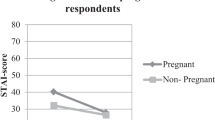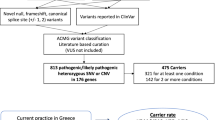Abstract
Next-generation sequencing enabled us to create a population-based expanded carrier screening (ECS) test that simultaneously tests for 50 serious autosomal recessive diseases. Before offering this test universally, we wanted to know what factors are related to intended participation and how the general public can be informed about the test without being influenced in their intention to participate. We studied this by measuring to what extent ‘message framing’ and ‘narrative information’ can influence people’s intended participation. Data were collected by means of an online survey of 504 potential users, and the factors examined were based on the Theory of Planned Behaviour and on previous research on intended participation in preconception carrier screening. Message framing was manipulated by explaining the risk of couple carriership in different ways, while narrative information was provided to only half of the respondents. The factors most positively related to intended participation were perceiving benefits of the screening, having a positive attitude towards the screening, having no religion, having an actual child wish and experiencing the choice to participate as easy. Perceived benefits and a positive attitude were most influential factors by far. Message framing and narrative information had no significant effect on intended participation, reinforcing that message framing and narrative information can help to inform the general public about ECS without influencing their intended participation. Future research should study if the importance of perceived benefits and a positive attitude can be replicated when other factors are included and when actual participation is measured instead of intended participation.
Similar content being viewed by others
Log in or create a free account to read this content
Gain free access to this article, as well as selected content from this journal and more on nature.com
or
References
Henneman L, Borry P, Chokoshvili D et al: Responsible implementation of expanded carrier screening. Eur J Hum Genet 2016; 24: e1–e12.
van der Hout S, Holtkamp KC, Henneman L, de Wert G, Dondorp WJ : Advantages of expanded universal carrier screening: what is at stake? Eur J Hum Genet 2017; 25: 17–21.
Plantinga M, Birnie E, Kaplan S et al: Population-based preconception carrier screening: How do potential users view a test for 50 severe autosomal recessive diseases? Eur J Hum Genet 2016; 24: 1417–1423.
Damman OC, Bogaerts NM, van Dongen D, Timmermans DR : Barriers in using cardiometabolic risk information among consumers with low health literacy. Br J Health Psychol 2016; 21: 135–156.
Scherer LD, Ubel PA, McClure J et al: Belief in numbers: When and why women disbelieve tailored breast cancer risk statistics. Patient Educ Couns 2013; 92: 253–259.
Fagerlin A, Zikmund-Fisher BJ, Ubel PA : Helping patients decide: ten steps to better risk communication. J Natl Cancer Inst 2011; 103: 1436–1443.
Edwards A, Gray J, Clarke A et al: Interventions to improve risk communication in clinical genetics: systematic review. Patient Educ Couns 2008; 71: 4–25.
Sheeran P, Conner M, Norman P : Can the theory of planned behavior explain patterns of health behavior change? Health Psychol 2001; 20: 12–19.
Janz NK, Becker MH : The Health Believe Model: a decade later. Health Educ Q 1984; 11: 1–47.
Ajzen I : The theory of planned behavior. Organ Behav Hum Decis Process 1991; 50: 179–211.
Lakeman P, Plass AM, Henneman L, Bezemer PD, Cornel MC, ten Kate LP : Preconceptional ancestry-based carrier couple screening for cystic fibrosis and haemoglobinopathies: What determines the intention to participate or not and actual participation? Eur J Hum Genet 2009; 17: 999–1009.
Chen LS, Goodson P : Factors affecting decisions to accept or decline cystic fibrosis carrier testing/screening: a theory-guided systematic review. Genet Med 2007; 9: 442–450.
Ioannou L, McClaren BJ, Massie J et al: Population-based carrier screening for cystic fibrosis: a systematic review of 23 years of research. Genet Med 2014; 16: 207–216.
Holtkamp KC, Mathijssen IB, Lakeman P et al: Factors for successful implementation of population-based expanded carrier screening: learning from existing initiatives. Eur J Public Health 2017; 27: 372–377.
Crombag NM, Schielen PC, Hukkelhoven CW et al: Determinants of first trimester combined test participation within central region of the Netherlands. Prenat Diagn 2015; 35: 486–492.
Adeola Animasahun B, Nwodo U, Njokanma OF : Prenatal screening for sickle cell anemia: awareness among health professionals and medical students at the Lagos University Teaching Hospital and the concept of prevention by termination. J Pediatr Hematol Oncol 2012; 34: 252–256.
Levin IP, Schneider SL, Gaeth GJ : All frames are not created equal: a typology and critical analysis of framing effects. Organ Behav Hum Decis Process 1998; 76: 149–188.
Tversky A, Kahneman D : The framing of decisions and the psychology of choice. Science 1981; 211: 453–458.
Akl EA, Oxman AD, Herrin J et al: Framing of health information messages. Cochrane Database Syst Rev 2011; 12: 1–84.
Winterbottom A, Bekker HL, Conner M, Mooney A : Does narrative information bias individual's decision making? A systematic review. Soc Sci Med 2008; 67: 2079–2088.
Bekker HL, Winterbottom AE, Butow P et al: Do personal stories make patient decision aids more effective? A critical review of theory and evidence. BMC Med Inform Decis Mak 2013; 13 (Suppl 2): S9.
Survey Sampling International. Survey sampling international. http://www.surveysampling.nl.
van den Berg M, Timmermans DR, Knol DL et al: Understanding pregnant women's decision making concerning prenatal screening. Health Psychol 2008; 27: 430–437.
Henneman L, Bramsen I, van der Ploeg HM et al: Participation in preconceptional carrier couple screening: Characteristics, attitudes, and knowledge of both partners. J Med Genet 2001; 38: 695–703.
Webb TL, Sheeran P : Does changing behavioral intentions engender behavior change? A meta-analysis of the experimental evidence. Psychol Bull 2006; 132: 249–268.
Acknowledgements
We thank Kate McIntyre for editing our manuscript.
Author information
Authors and Affiliations
Corresponding author
Ethics declarations
Competing interests
The authors declare no conflict of interest.
Additional information
Supplementary Information accompanies this paper on European Journal of Human Genetics website
Rights and permissions
About this article
Cite this article
Voorwinden, J., Buitenhuis, A., Birnie, E. et al. Expanded carrier screening: what determines intended participation and can this be influenced by message framing and narrative information?. Eur J Hum Genet 25, 793–800 (2017). https://doi.org/10.1038/ejhg.2017.74
Received:
Revised:
Accepted:
Published:
Issue date:
DOI: https://doi.org/10.1038/ejhg.2017.74
This article is cited by
-
Anecdotes impact medical decisions even when presented with statistical information or decision aids
Cognitive Research: Principles and Implications (2024)
-
GP-provided couple-based expanded preconception carrier screening in the Dutch general population: who accepts the test-offer and why?
European Journal of Human Genetics (2020)



